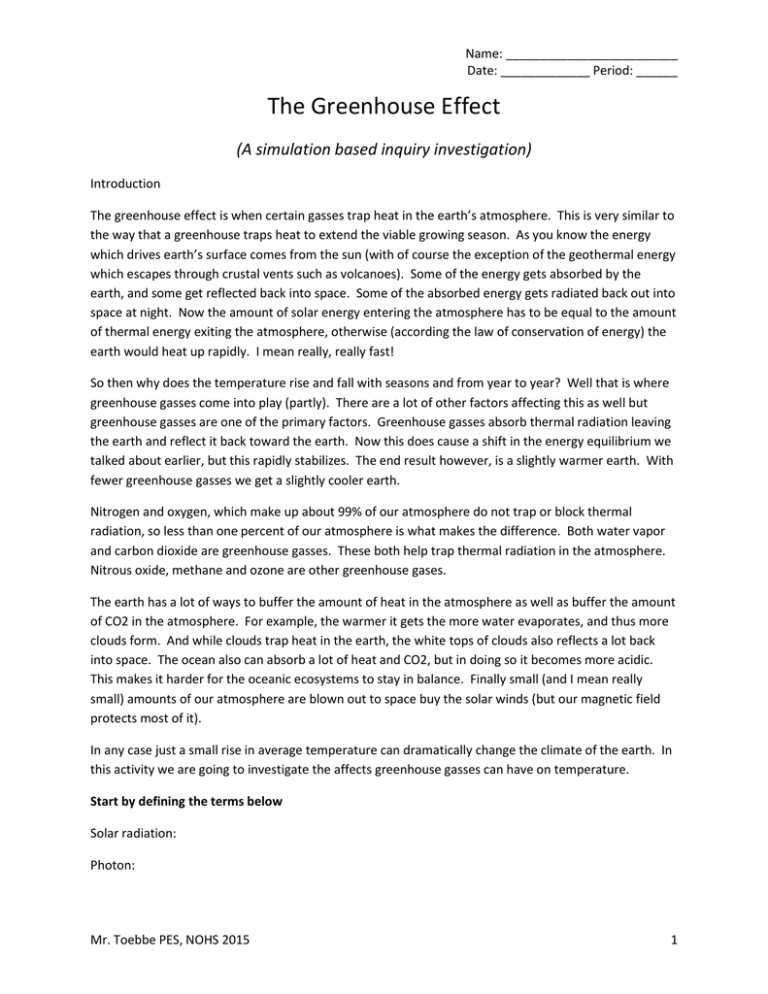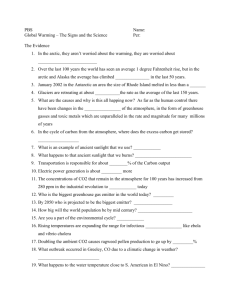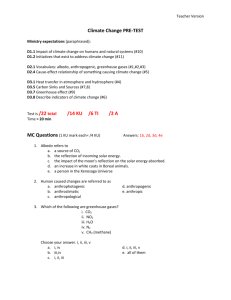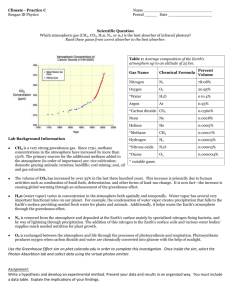Greenhouse Effect Simulation Worksheet
advertisement

Name: _________________________ Date: _____________ Period: ______ The Greenhouse Effect (A simulation based inquiry investigation) Introduction The greenhouse effect is when certain gasses trap heat in the earth’s atmosphere. This is very similar to the way that a greenhouse traps heat to extend the viable growing season. As you know the energy which drives earth’s surface comes from the sun (with of course the exception of the geothermal energy which escapes through crustal vents such as volcanoes). Some of the energy gets absorbed by the earth, and some get reflected back into space. Some of the absorbed energy gets radiated back out into space at night. Now the amount of solar energy entering the atmosphere has to be equal to the amount of thermal energy exiting the atmosphere, otherwise (according the law of conservation of energy) the earth would heat up rapidly. I mean really, really fast! So then why does the temperature rise and fall with seasons and from year to year? Well that is where greenhouse gasses come into play (partly). There are a lot of other factors affecting this as well but greenhouse gasses are one of the primary factors. Greenhouse gasses absorb thermal radiation leaving the earth and reflect it back toward the earth. Now this does cause a shift in the energy equilibrium we talked about earlier, but this rapidly stabilizes. The end result however, is a slightly warmer earth. With fewer greenhouse gasses we get a slightly cooler earth. Nitrogen and oxygen, which make up about 99% of our atmosphere do not trap or block thermal radiation, so less than one percent of our atmosphere is what makes the difference. Both water vapor and carbon dioxide are greenhouse gasses. These both help trap thermal radiation in the atmosphere. Nitrous oxide, methane and ozone are other greenhouse gases. The earth has a lot of ways to buffer the amount of heat in the atmosphere as well as buffer the amount of CO2 in the atmosphere. For example, the warmer it gets the more water evaporates, and thus more clouds form. And while clouds trap heat in the earth, the white tops of clouds also reflects a lot back into space. The ocean also can absorb a lot of heat and CO2, but in doing so it becomes more acidic. This makes it harder for the oceanic ecosystems to stay in balance. Finally small (and I mean really small) amounts of our atmosphere are blown out to space buy the solar winds (but our magnetic field protects most of it). In any case just a small rise in average temperature can dramatically change the climate of the earth. In this activity we are going to investigate the affects greenhouse gasses can have on temperature. Start by defining the terms below Solar radiation: Photon: Mr. Toebbe PES, NOHS 2015 1 Name: _________________________ Date: _____________ Period: ______ Infrared radiation: Infrared photon: Predictions 1. Which gas do you think will have a greater effect on temperature, methane, carbon dioxide or water vapor? 2. What do you think will have a greater effect on temperature, cloud cover or greenhouse gasses? 3. Will clouds make it colder or warmer? 4. Do you think it’s really possible to replicate the greenhouse effect with layers of glass? Procedures Open the simulation Go to mrtoebbesclassroom.com. Open the meteorology tab under PES. Scroll to the bottom and click the greenhouse effect link This will open the simulation page, click the green run now button to start the simulation. Part A Take a minute to familiarize yourself with the simulation. What do the yellow dots represent? What do the red dots represent? How does the motion of the two photon types compare to each other? Slide the greenhouse gas concentration controller to the left (none) and observe what happens to the temperature. Slide it over the right (lots) and observe what happens to the temperature. Click the atmosphere during today button under the concentration controller. Give the temperature some time to stabilize, and record what it stops at. Mr. Toebbe PES, NOHS 2015 2 Name: _________________________ Date: _____________ Period: ______ Part B Use the atmosphere buttons (today, 1750, ice age) to find out when the highest concentration of CO2 in the atmosphere happened. _______________________ Use the atmosphere buttons to find when the highest average global temperature was ______________________ Record the CO2 concentrations and average temperatures for each of the three atmosphere concentrations (ice age, 1750 and today). Co2 concentration (ppm) Time period Open excel and record the data from above in two columns, the first will be CO2 concentration, the second will be average temperature. Highlight the two columns and create a graph (scatter plot) Consider that the last ice age represented by this simulation occurred about 11,000 years ago, what is the average rate that CO2 concentration is increasing at? ________________________ Based on only CO2 (and ignoring the other factors for now) if the CO2 concentration continues to rise at the rate you calculated above, how many years will it be until the average temperature reaches 65˚F? ________________________ Based on the CO2 to temperature graph you made earlier how many ppm of CO2 would be in the atmosphere when the concentration slider is moved all the way to the right? ________________________ Qualitative Analysis 1. Do you think that the CO2 concentration has really been increasing at a constant rate since the ice age, or has it gone up and down in multiple intervals? 2. As of now, do you think that the greenhouse effect is good or bad? Use evidence to support your answer and be specific as possible. Mr. Toebbe PES, NOHS 2015 3








